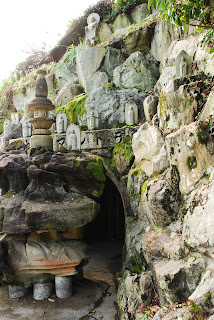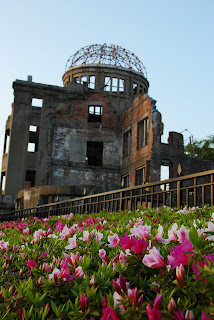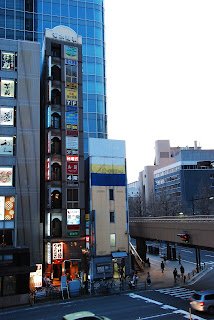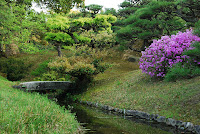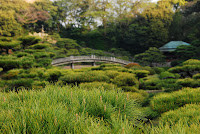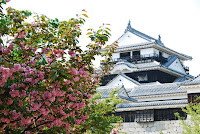Since the last post went on a bit longer than I'd expected, the last little bit of Matsuyama got shoved into this one. I didn't want to scrimp too much on this part, because on the morning of my departure from Shikoku I visited what has got to be the weirdest temple in all of Japan - Ishite-ji, number 51 of Shikoku's 88-temple pilgrimage.
Well - that's not quite accurate. The temple is a little unusual in that it's more cluttered and sprawling and less organised than most others I've seen - but that wouldn't in itself be enough to write about.
What was cool, however, was the surrounding area. Ishite-ji is nestled at the foot of a tall, forested hill, with my access route being a path over said hill. In fact, the hill was crisscrossed by a spiderweb of little unkempt tracks, so it was purely by good fortune that I happened to follow the one that went past the hilltop. From here, I got some very pretty views of the city...
...and of a huge Buddha statue someone built on a nearby hill for no discernible reason other than that it never hurts to have one more Buddha statue.
Then, of course, there was the random golden sphere which seemed to serve no particular purpose - it was completely deserted apart from a few builders, and I'm not sure what exactly they were doing there. I couldn't figure out whether the whole place was derelict or unsafe to enter or anything - the path leading up to it was pretty overgrown and the inside looked pitch black, so I gave it a miss. It was only later that I found out that this place is packed with disturbing statues which would have been worth a visit.
Now what makes Ishite-ji really weird is one of its least-known entrances. Matt at my hostel had told me of a tunnel-like cave which led to this temple, and this was what I was originally looking for when I meandered around the hill and eventually reached the hilltop instead. The cave mouth turned out to be a little further down the road, right by the roadside but cleverly hidden by some carved stonework so that at first glance it wasn't apparent that there was anything behind it.
I had imagined a short passageway, maybe 20m long but not much more than that - I could not have been more wrong. I'm not embarassed to admit that this tunnel creeped me the hell out. It was some 250m long, low enough that I had to stoop and lit only by tiny lamps at intervals which left 90% of it in near-complete blackness - just enough to let the dozens of little 2-foot tall stone statues cast some seriously eerie shadows. It didn't help that these statues also all wore clothes like the ones pictured in the first photo of this post, which moved in the breeze to add an extra bit of realism to the shadows. There were also a few larger alcoves which were guarded by 10ft statues staring grimly out of the blackness.
Here's the exit at the temple end of the tunnel. Here's a taster of the inside, though rather better lit than when I was there. In conclusion - yes, I'm a massive wuss...
And on that note, onwards to Hiroshima! This is one of those places that will only ever be famous for one thing. Trying to promote Hiroshima for its pretty rivers or anything else is a bit like seeing Daniel Radcliffe/Elijah Wood in any non-Harry Potter/Frodo role: it just doesn't work. They will always be those two characters, and Hiroshima will always be the city that got nuked.
That said, Hiroshima is a very pleasant city to while away a few days in. Aside from everything being named "Peace..." - pagodas, parks, boulevards, everything - I can't really think of anything unpleasant about it. There are no signs at all that this city was a nuclear wasteland less than 70 years ago - except for the A-bomb dome, a powerful ruin right in the city centre. It is almost exactly below the hypocentre of the bomb (which exploded above ground level for maximum effect), and by some freak incident the framework of the structure remained standing. During the cleanup efforts in the 50s it was decided to keep the dome as a memorial, and it's a pretty haunting one. A nuclear blast is one of those things it can't be possible to imagine unless one's been affected by one - watching them (e.g. here or here or here) never fails to fill me with a mixture of awe and horror.
Right next to the A-bomb dome is the Peace Park, which covers an island in one of Hiroshima's four rivers and is packed with memorials and monuments to all imaginable population groups and minorities affected by the bomb. It also houses the "Flame of Peace", which will be extinguished once all nuclear weapons on Earth have been destroyed.
Despite its squat, unattractive exterior, the A-bomb museum is pretty interesting. I hadn't known that the mayor of Hiroshima has written a letter protesting every single nuclear test that has ever occurred - they covered several walls! The other exhibits do a fair job at conveying the aftereffects of the blast - some are positively chilling, such as this tricycle.
On a rather more cheerful note, the food in Hiroshima is excellent! Okonomiyaki literally translates as "grilled 'whatever-you-want'", and while this doesn't mean an unlimited meatfest such as the more extravagant mind might conjure up, the result is still tasty. The Hiroshima version consists of yakisoba noodles, cabbage, pork, beef and various squiddy seafood all grilled with batter and egg to make a giant pancake layered with all sorts of goodness and topped with an unidentified but fantastic brown sauce. The whole thing is then served on the grill, and you get a spatula to help yourself with. Winner!
Followers of this blog will remember the Three Views of Japan, one of which I visited in northern Honshu (and in the previous blog post); the time had now come to find another one of these. Fortunately, I had the common sense to leave early and arrived on Miyajima Island at 6.45am, thus avoiding the crowds. And what crowds they were...the tour groups began streaming in around the same time I left, and they were fearsome indeed.
This island is home to the Floating Torii (the archways which mark the entrance to a shrine). I had done my homework and had even checked the tide timetable to make sure I came on the right day - at low tide, the floating torii actually stands in an expanse of mud which I imagine would be rather less photogenic. As it was, though, only a handful of other early birds were at the shrine with me and I spent a good hour and a half wandering its planks and gangways in the search for the best views.
Now this is undeniably a beautiful affair, but sadly the Japanese ability to build the most monstrous concrete hotel blocks right in front of their greatest treasures rears its ugly head yet again. Fortunately, the Inland Sea's far shore is far enough away that this isn't too big a deal, but still - what on Earth were they thinking?!
And at long last, we get to my last stop in Japan. At the southernmost extremity of Kyushu, Kagoshima lies along a bay across which is one of the world's most active volcanoes. It is, in fact, officially currently erupting, though nobody seems to mind very much: the tourism industry (read: gift and snack shops) along its flank are thriving. I didn't have the time to actually head over there myself, but upon my 5am start to get to nearby Kirishima-Yaku National Park for a good day's hiking I was treated to a rather shapely little plume by Sakurajima.
This set the mood nicely for the rest of the day, which was spent in a volcanic wasteland which, while cool, was no match for New Zealand's Tongariro National Park. Alas, it's truly a hard life having seen some of the world's more spectacular places (an unreasonable fraction of which seem to be crammed into New Zealand)!
Still, it was nice to get out and about once more, and the landscape provided an interesting contrast from the lush greenery of Shikoku.
My original plan had been to hike across a chain of volcanic peaks from one hamlet to another, but since the second volcano in the chain was in the process of blowing its top off the path was closed. This left me to climb Karakuni-jima, where the above shots were taken, and then wander around a nearby crater lake before heading back to complete the loop. On the way, I met another English chap named Benedict, who was excellent company and had conveniently stayed in a hotel next to the bus station the previous night. This meant that a cheeky onsen visit was on the cards after the hike, and I can confirm that there is no better way to finish a wander than a hot soak.
And so ended the penultimate stage of my adventure. After a few uneventful days in Fukuoka which were mostly spent wandering the aisles of a 5-story camera shop but not buying anything, I hopped on a plane to Korea. More on that soon...
Well - that's not quite accurate. The temple is a little unusual in that it's more cluttered and sprawling and less organised than most others I've seen - but that wouldn't in itself be enough to write about.
What was cool, however, was the surrounding area. Ishite-ji is nestled at the foot of a tall, forested hill, with my access route being a path over said hill. In fact, the hill was crisscrossed by a spiderweb of little unkempt tracks, so it was purely by good fortune that I happened to follow the one that went past the hilltop. From here, I got some very pretty views of the city...
...and of a huge Buddha statue someone built on a nearby hill for no discernible reason other than that it never hurts to have one more Buddha statue.
Then, of course, there was the random golden sphere which seemed to serve no particular purpose - it was completely deserted apart from a few builders, and I'm not sure what exactly they were doing there. I couldn't figure out whether the whole place was derelict or unsafe to enter or anything - the path leading up to it was pretty overgrown and the inside looked pitch black, so I gave it a miss. It was only later that I found out that this place is packed with disturbing statues which would have been worth a visit.
Now what makes Ishite-ji really weird is one of its least-known entrances. Matt at my hostel had told me of a tunnel-like cave which led to this temple, and this was what I was originally looking for when I meandered around the hill and eventually reached the hilltop instead. The cave mouth turned out to be a little further down the road, right by the roadside but cleverly hidden by some carved stonework so that at first glance it wasn't apparent that there was anything behind it.
I had imagined a short passageway, maybe 20m long but not much more than that - I could not have been more wrong. I'm not embarassed to admit that this tunnel creeped me the hell out. It was some 250m long, low enough that I had to stoop and lit only by tiny lamps at intervals which left 90% of it in near-complete blackness - just enough to let the dozens of little 2-foot tall stone statues cast some seriously eerie shadows. It didn't help that these statues also all wore clothes like the ones pictured in the first photo of this post, which moved in the breeze to add an extra bit of realism to the shadows. There were also a few larger alcoves which were guarded by 10ft statues staring grimly out of the blackness.
Here's the exit at the temple end of the tunnel. Here's a taster of the inside, though rather better lit than when I was there. In conclusion - yes, I'm a massive wuss...
And on that note, onwards to Hiroshima! This is one of those places that will only ever be famous for one thing. Trying to promote Hiroshima for its pretty rivers or anything else is a bit like seeing Daniel Radcliffe/Elijah Wood in any non-Harry Potter/Frodo role: it just doesn't work. They will always be those two characters, and Hiroshima will always be the city that got nuked.
That said, Hiroshima is a very pleasant city to while away a few days in. Aside from everything being named "Peace..." - pagodas, parks, boulevards, everything - I can't really think of anything unpleasant about it. There are no signs at all that this city was a nuclear wasteland less than 70 years ago - except for the A-bomb dome, a powerful ruin right in the city centre. It is almost exactly below the hypocentre of the bomb (which exploded above ground level for maximum effect), and by some freak incident the framework of the structure remained standing. During the cleanup efforts in the 50s it was decided to keep the dome as a memorial, and it's a pretty haunting one. A nuclear blast is one of those things it can't be possible to imagine unless one's been affected by one - watching them (e.g. here or here or here) never fails to fill me with a mixture of awe and horror.
 |
| A pillar warped in the heat of the explosion. |
 |
| The A-bomb dome makes for a rather better background for the Flame of Peace... |
 |
| ...than the rather drab-looking museum. |
 |
| And for no good reason, Hiroshima castle's walls at sunset. I really need to get home and start straightening all these photos... |
This island is home to the Floating Torii (the archways which mark the entrance to a shrine). I had done my homework and had even checked the tide timetable to make sure I came on the right day - at low tide, the floating torii actually stands in an expanse of mud which I imagine would be rather less photogenic. As it was, though, only a handful of other early birds were at the shrine with me and I spent a good hour and a half wandering its planks and gangways in the search for the best views.
Now this is undeniably a beautiful affair, but sadly the Japanese ability to build the most monstrous concrete hotel blocks right in front of their greatest treasures rears its ugly head yet again. Fortunately, the Inland Sea's far shore is far enough away that this isn't too big a deal, but still - what on Earth were they thinking?!
 |
| A fair few of the monks sported some of the most excellent minty blue kit anyone could wish for... |
 |
| Gotta get those cherry blossoms in the frame! |
This set the mood nicely for the rest of the day, which was spent in a volcanic wasteland which, while cool, was no match for New Zealand's Tongariro National Park. Alas, it's truly a hard life having seen some of the world's more spectacular places (an unreasonable fraction of which seem to be crammed into New Zealand)!
Still, it was nice to get out and about once more, and the landscape provided an interesting contrast from the lush greenery of Shikoku.
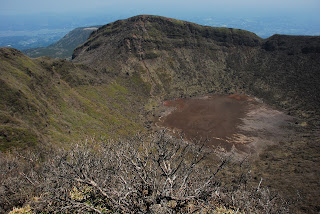 |
| This used to be a crater lake used to film the villain's HQ in 007: You Only Live Twice. Then the volcano erupted. No more lake... |
And so ended the penultimate stage of my adventure. After a few uneventful days in Fukuoka which were mostly spent wandering the aisles of a 5-story camera shop but not buying anything, I hopped on a plane to Korea. More on that soon...





